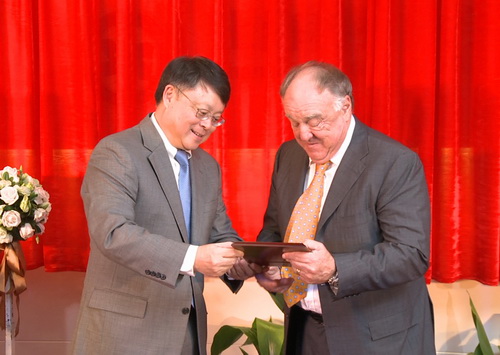On October 12th, 2012, the inauguration of the Shanghai Institute for Advanced Immunochemical Studies (SIAIS) of ShanghaiTech University was held in CAS Shanghai Pudong Science & Technology Park. The President of CAS Shanghai Branch, Dr. JIANG Mianheng, Shanghai Pudong New Area Party Secretary, Mr. XU Lin, Deputy Mayor of Shanghai, Dr. SHEN Xiaoming, and CAS academicians, Dr. RAO Zihe, Dr. SHEN Wenqing, and Dr. CHEN Xiaoya, et al. attended the ceremony.
President JIANG presented Dr. Richard A. Lerner the Appointment Letter of Founding Director of SIAIS. In his acceptance speech, Dr. Lerner expressed his vision of making SIAIS a most prestigious world-class institute in immunochemistry and antibody research, and his plan of recruiting and training leading scientists from China and overseas.
In president JIANG’s congratulation speech, he pointed out that China is currently experiencing a pivotal period of deepening the reform and opening-up and accelerating the transformation of the economic development path. He emphasized that science and technology are playing an increasingly important role in meeting various challenges of new energy development, environment protection, people's healthcare, and employment. President JIANG said that the current developing strategy of driven-via-innovation and grown-through-transformation sets a much higher standard for the researchers and scientists. The establishment of SIAIS is one of the critical steps by ShanghaiTech University to meet the demands of promoting science and technology and enhancing people's health in China. He believes that SIAIS could live up to the expectations and make important and significant contributions to the health of mankind.
The Deputy Mayor of Shanghai, Dr. SHEN Xiaoming, addressed in his speech that biological medicine is of essential importance to national well-being and the people's livelihood. Immunochemistry is the foundation of therapeutic antibody research, and an important scientific discipline in the discovery and development of new medicines. The establishment of SIAIS meets the need of the economic restructuring and innovation-driven development of Shanghai; it is an important step for ShanghaiTech University to achieve its initiatives of research and education integration, operative structure reform and innovation, and top level international scientific collaboration; it marks a significant milestone for ShanghaiTech University during its preparation.
Dr. FENG Songlin, President of Shanghai Advanced Research Institute of Chinese Academy of Sciences (SARI-CAS), addressed that SARI will continue the momentum in the preparation process, take advantage of the effective mode in cross-disciplinary scientific research and technology transfer, and work closely with ShanghaiTech University to make SIAIS a great success.
SIAIS, jointly founded by ShanghaiTech University and SARI-CAS, is dedicated to improving human health through scientific / academic excellence, multi-disciplinary crossing, and innovative drug discovery. The institute will focus on cutting-edge platform technologies, novel therapeutic targets, and scientific breakthroughs.
The vice president of SARI-CAS Dr. JIANG Biao introduced that the mission of SIAIS is to build a strong multi-functional and cross-disciplinary foundation to marry basic research with clinical studies; and medical applications with biotechnology and pharmaceutical industries. SIAIS provides a stage for the top talents of innovation as well as a cradle for the future young talents of China. SIAIS will lead in the discovery and commercialization of novel antibody applications.
SIAIS is establishing a Young Scholar Foundation to select outstanding young scientists and students each year to attend famous universities or institutes in the U.S. and Europe.
SIAIS-ShanghaiTech follows the Director Responsibility System with the governing body of The Board of Directors and Scientific Advisory Committee. The Founding Director, Dr. Richard A. Lerner, is the former President of The Scripps Research Institute and a member of the U.S. National Academy of Sciences, American Academy of Medical Sciences, and American Academy of Arts and Sciences. Dr. Lerner's career in science is one of the most distinguished and decorated. His achievements and contributions are recognized worldwide. As a pioneer and one of the founding fathers in immunochemistry theory, he has developed almost every important research method and tool such as combinatorial antibody library approach, catalytic antibody approach, the intra-cellular combinatorial antibody library approach, etc. Dr. Lerner, together with Sir Gregory P. Winter, owns the patent for the world's largest drug on the market, the monoclonal antibody Humira. Dr. Lerner has already invited several famous US/Canada/UK scientists to join SIAIS.

